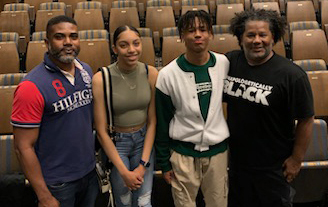Our most recent production Commemorating Juneteenth was designed to celebrate the emancipation of enslaved Africans, but it also was purposed to educate our audiences about the African American community’s constant struggle to achieve independence, freedom, and social justice over centuries.
The Juneteenth performance is a multimedia production with dance, theater, music, poetry, script writing, mask making, and set design in our commemoration of Black History and Black Triumph. Creative Outlet uses every aspect of arts programming as both a vehicle and a tool for healing the psyche, promoting wellness, and encouraging social activism and emotional expressiveness. Every artist is engaged in telling our story through our movement. The rehearsal process, for instance, is a time to be in sync with the choreographer’s intentions, it also is a unifier, setting the foundations for the dance company to become Griot, cultivating a story that is spiritual, artistic, holistic, and inspirational.
“GONE TOO SOON” - An Ode to My Father by Michael C. Smith Robert A. Smith Sr was Father to me, my four Brothers, my three Sisters and a Grandchild. We grew up on the 200 block of Halsey Street in Bed/Stuy Brooklyn during the 1940s & 1950s. He was “Smitty”, Big Smitty, and Mr. Smith and was known throughout the neighborhood especially by our friends who did not have a Father of their own. He was an avid basketball fan having coached a local Team called the RENS at First AME Zion Church in Bedford/Stuyvesant. He also refereed basketball games throughout Brooklyn through an Organization called S.U.B.O.A. A hard-working man who sometimes held down 3 jobs at a time, he who instilled that work ethic in all his children. He was a loving Family man who enjoyed Duke Ellington and Count Basie music. Despite his size (over 6 feet tall and 200+ pounds), he was a gentle giant. Still missed to this Day.
It always has been crucial for me to assist underrepresented communities pursue their artistic endeavors. Racial disparities have caused our communities to have minimal exposure to the performing arts; specifically, these communities that lack access to — not only high-level professional artists that are willing to support their artistic journey but also to — spaces and locations to move and think freely without restriction. To, in effect, dance.
Through Creative Outlet, I’ve been able to reach the underserved in many communities of Kings County, including Central Brooklyn, East New York, Flatbush, and Canarsie, and contributed to young people achieving a high level of artistic growth.
Creative Outlet also has helped to promote social and racial justice by encouraging diversity and inclusion in the performing arts industry directly in Brooklyn. In addition to providing scholarships to children, we offer the best teachings and instructions we can give.
With our experience, skills, and resources, why shouldn’t we? Creative Outlet’s creative process is a symbiotic one for all involved in the Creative Outlet, including the audience we strive to engage. We challenge our students; they, in turn, challenge us. They inspire us to create new projects, we inspire them to dance to the fullest the stories they live.
Yet, we never lose sight that the audience for whom we perform are essential to Creative Outlet’s creative process.
In the JGCO program, the joyous, jubilant choreographic piece, Thank You, celebrates the 60th Anniversary of Rev. Martin Luther King, Jr’s August 1963 civil rights March on Washington; and the Four Little Girls, which recognizes the 60th Anniversary of the tragic Baptist Church Bombing in Birmingham, Alabama, that occurred in March of that year, causes audience members to weep. At those moments, the audience is in step with our dancers.
Over the past 28 years of my teaching, dancing and choreography experience, I have sought to inspire, motivate, and nurture the next generation of professional artists by providing them with a platform, mentorship, and a safe place to succeed. When I am told that members of the audience wept or were overcome with joy to get on their feet and dance, I know that I have done my job. By having cultural, social pieces via art and culture that tell African American stories, we keep these seminal stories from being lost. (To be continued) – Jamel Gaines


